GNOME 3.4 Release Notes
Introduction
The GNOME
Project is an international community that works to make great
software available to all. GNOME focuses on ease of use, stability,
first-class internationalization, and accessibility. GNOME is Free
and Open Source Software. This means that all our work is free to
use, modify and redistribute.
GNOME
is released every six months. Since the last version, 3.2,
approximately 1275 people made about 41000 changes to GNOME.
Interested in what we do? Follow us on Identi.ca,
Twitter
or Facebook.
If
you would like to help make our products even better, join
us.
We always welcome more people who can translate from English, assist
with marketing, write documentation, test, or do development.
What's New for Users
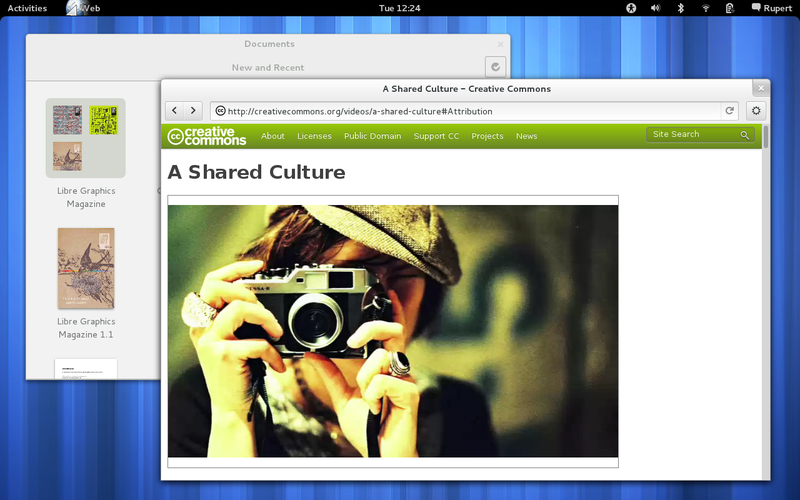
3.4 is the
second GNOME release since 3.0 back in April 2011. It brings a large
number of improvements to the user experience, including many bug
fixes and small enhancements. The result is a shinier, more polished,
more reliable GNOME 3.
This
release also contains some important new developments. Our
applications have been a major focus for recent design and
development effort, and a host of applications have had significant
updates for this release. You will also see improvements to the
building blocks that our applications have been made with. This
includes smooth scrolling, refreshed user interface components, a
much refined visual theme and application menus.
Other
highlights for this release include a new document search facility, a
new application called Boxes, video calling, and a new animated
background that updates over the course of the day. Enjoy!
New Look GNOME 3 Applications
Our applications have been a major theme for this release cycle. The new applications that were released in 3.2 have all received major updates that make them better looking and more pleasurable to use. Several existing applications have also received an overhaul so that they are more consistent and integrated with GNOME 3.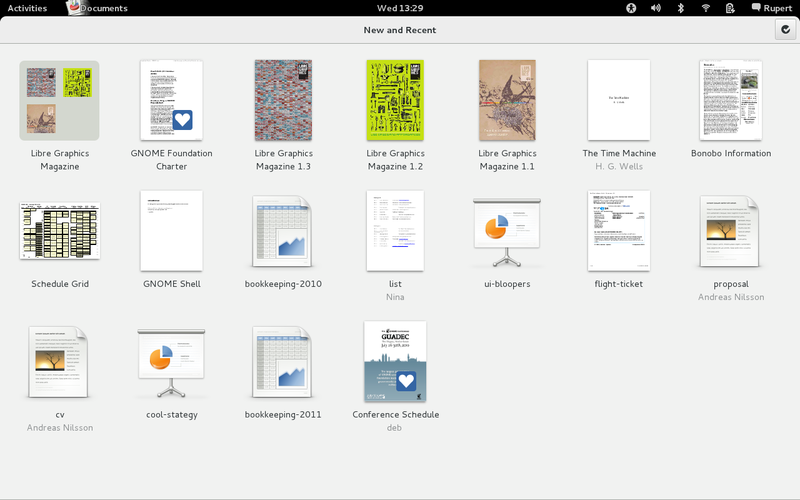
Documents,
the new application that allows you to easily browse, search and
organize documents, has received a major design refresh. The result
is a fresher, cleaner application. The new version comes with a
refreshed interface, the ability to create collections of documents
and support for printing.
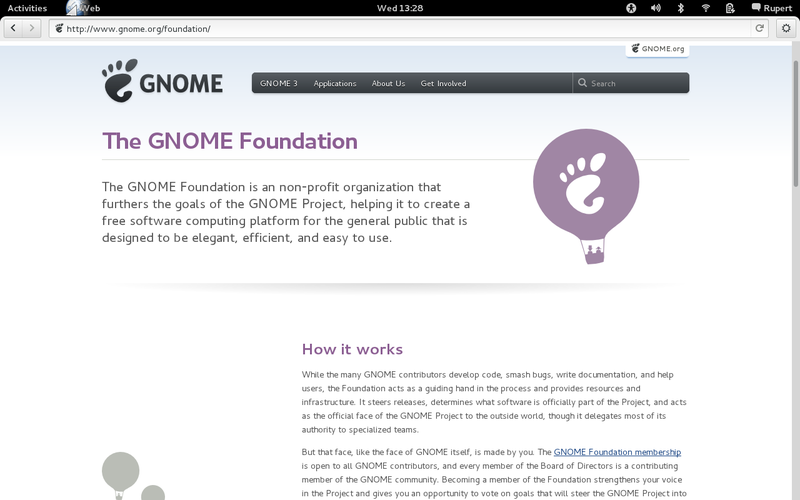
Epiphany,
the GNOME web browser, has been renamed Web. It has been given
a beautiful new interface for 3.4, which includes a redesigned
toolbar and 'super menu'. There have also been a number of
performance improvements, including faster browsing history.
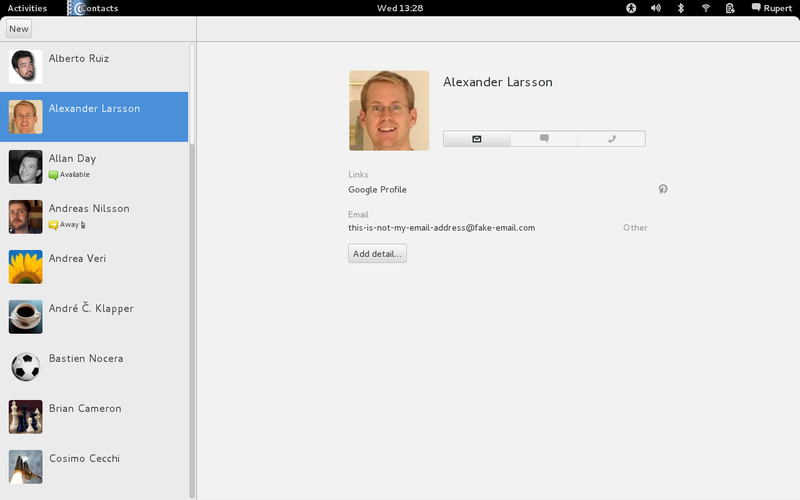
Our
new contact application has also received a major update. The main
contact list has been improved as has the layout of contact details.
Contacts sports a number of other new features, including
inline linking suggestions and a new avatar selector.
Disks
is the new name for GNOME Disk Utility, and it has had a
major overhaul. The tool, which allows you to manage the disks on
your computer, has a refreshed interface, integrates better with
GNOME and also received several new features.
Another
tool we have updated is Passwords and Keys. It has also been
given a much more refined and elegant user interface.
Document Search
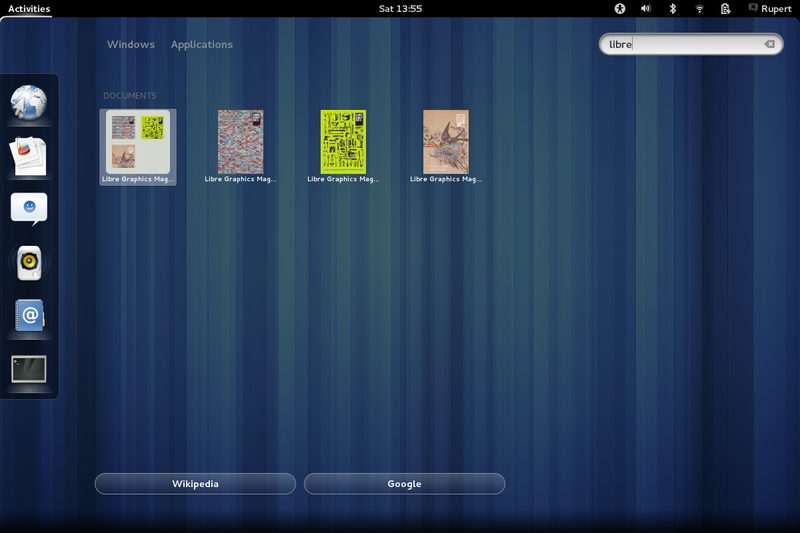
Searching
from the Activities Overview already gives you a quick way to access
applications, contacts and system settings. A big new feature for
this release is the addition of documents to these search results. It
means that document search is always at hand.
The
new document search facility is provided directly by the Documents
application. As a result, you can search the documents you have on
your computer as well as those stored in your online accounts.
This
ability for Activities Overview search to provide a window into your
applications will be extended in future releases to include other
types of content, such as Music and Videos.
Application Menus
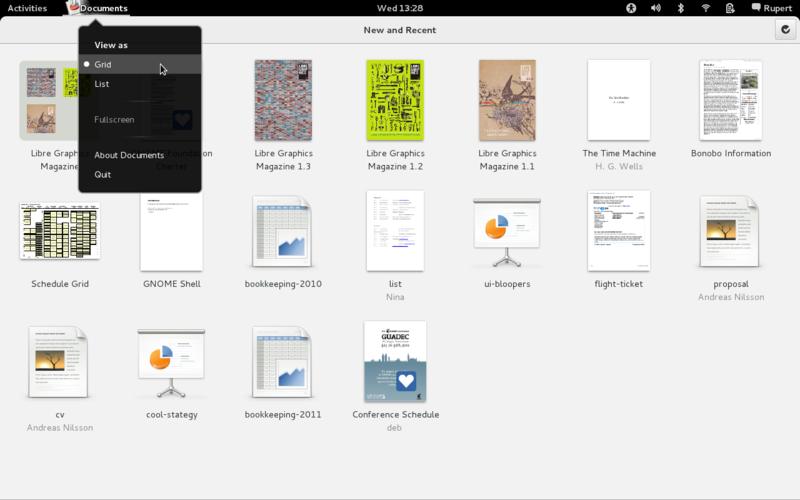
Application
menus are a new feature that will become an increasingly familiar
part of our applications in the future. These menus, which are
labelled with the application's name and can be seen in the top bar,
provide a new space for options that affect the whole application (as
opposed to specific windows), such as application preferences and
documentation.
A
number of applications, including Documents, Web and
Contacts, are already making use of application menus for this
release.
An
exception will be made for focus-follows-mouse
users; for them, a classic menu bar will be shown.
Refreshed Interface Components
A
number of our application interface components have been modernized
this release. These changes will make applications more elegant and
easier to use. They are particularly focused on removing difficult
click targets.
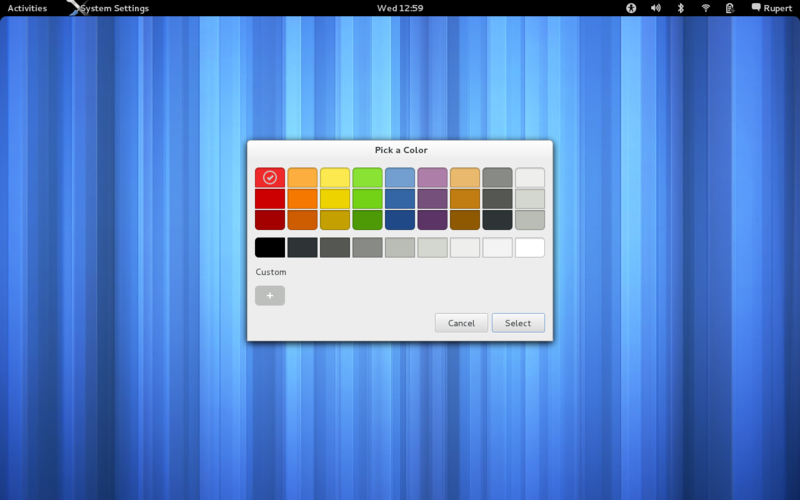
Our
color chooser dialog has been brought up to date for 3.4. The new
design provides easy access to a tasteful palette of colors, as well
as a mechanism to create a set of custom colors. It is much more
straightforward to use than the previous version.
Scrollbars
are another component that have been updated for 3.4. The new version
takes up less space and removes the tiny 'stepper' buttons that
traditionally feature on scrollbars, and which can be a particularly
difficult click target.
We
also revised the design of spin buttons for 3.4, which used to be
fiddly. The new versions are much easier to use and look great too.
When
maximized, certain applications will now hide their title bar. This
ensures more space is available for the application.
A Bonanza of Smaller Improvements
Incremental
improvements and polishing has been a big focus for this release. The
result is a large number of smaller improvements which add up to a
big increase in quality.
The
visual theme is a lot more polished in this release. Many of the
changes are subtle, but almost every part of the theme has been
improved in some way. The overall effect is much better looking
applications.
A
new initiative, called Every
Detail Matters,
has been focusing on improving the quality of the Activities Overview
for this release. Thanks to these efforts, lots of small details have
been taken care of, including improved application launcher labels,
new window labels and captions, better keyboard navigation, more
legible text styles and an easier to use dash.
There
are many other incremental improvements in GNOME 3.4. As ever, there
are too many to list here, but they include:
- Network password dialogs, including those for VPN passwords, were stuck on GNOME 2 until this release. They have now been fully integrated with the GNOME 3 experience.
- The return of Wanda the Fish! Yes Wanda, our trusty friend from GNOME 2, has returned. She's an easter egg, so we won't tell you exactly where to find her. Search and you'll receive.
- Our built in screen recorder now produces smoother videos while also using less system resources. To use it, simply press Control+Shift+Alt+R.
- The visual layout of system modal dialogs has been improved since 3.2. They look much nicer as a result.
- Notification pop-ups are more intelligent now and will avoid the mouse or touchpad pointer, so that they won't get in your way.
- Another important enhancement to notifications is that the message tray, which displays a summary of your notifications, is now shown if you haven't interacted with your device for a short period of time. This makes it easier to be aware of ongoing conversations or unanswered messages.
Smooth Scrolling
Scrolling
has got smooth in GNOME 3.4. In previous releases scrolling content
could be a slightly abrupt affair. Now it is slick and graceful.
Scroll operations gradually ease to a halt and have a tactile,
physical feel to them. This is a big improvement which will make
GNOME applications far more pleasurable and satisfying to use.
Smooth
scrolling is the first result of our ongoing touch input work, which
is planned to deliver more features in the future.
New Animated Background

The
default background (or 'wallpaper') has been updated for this
release. The new version is a new take on the stripes theme from the
previous background. The new background is also dynamic, becoming
brighter and more radiant during the day, and dark and shadowy in the
evening.
Improved System Settings
System
Settings have received a number of updates for 3.4. These changes
include:
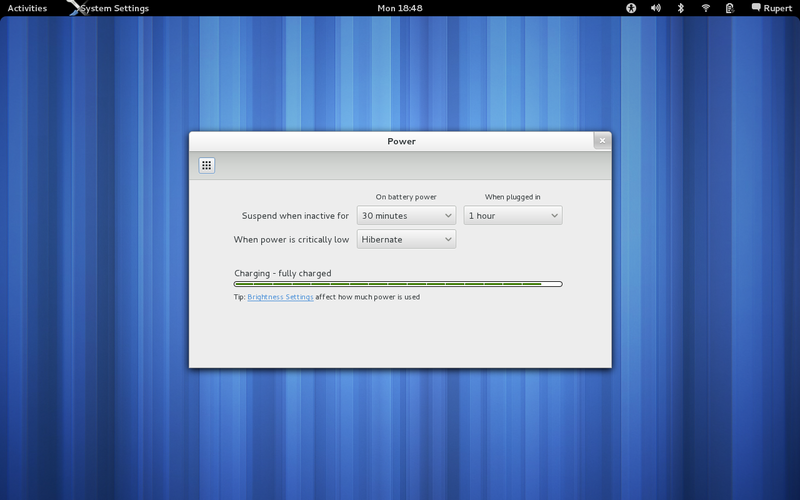
- Improved network panel layout, which now allows you to forget the configuration of individual networks.
- A better looking power panel, which includes a redesigned status section.
- Greatly enhanced Wacom graphics tablet support, including calibration and button mapping, as well as the new ability to configure multiple tablets.
- Easier navigation thanks to the renaming of some panels and an updated 'All Settings' button.
Better Hardware Support
Several
of the smaller improvements that feature in this release address
hardware support and integration, making GNOME 3 work with more
hardware devices, and providing a more seamless experience.
- Various color calibration improvements, which will now remember which device a particular color profile is for.
- Better handling of docking stations and external monitors, so that a laptop will now stay running (and not suspend) when it is connected to an external monitor, even if the lid is closed.
- Support for volume keys on USB speakers and headsets.
- New support for multiseat setups, such as pluggable USB multiseat devices.
Documentation That Really Helps You
Traditional
user documentation is written like a paper book; a good story, but it
is very long and takes time to read through. It's not ideal if you
just want to quickly find out how to perform a certain task. To
address this, applications are gradually updated to provide
topic-orientated documentation. The following applications provide
new documentation in GNOME 3.4:
- The disk usage analyzer Baobab
- The archive manager File Roller
- The log file viewer
- The dialog box tool Zenity
Video Calling and Live Messenger Support
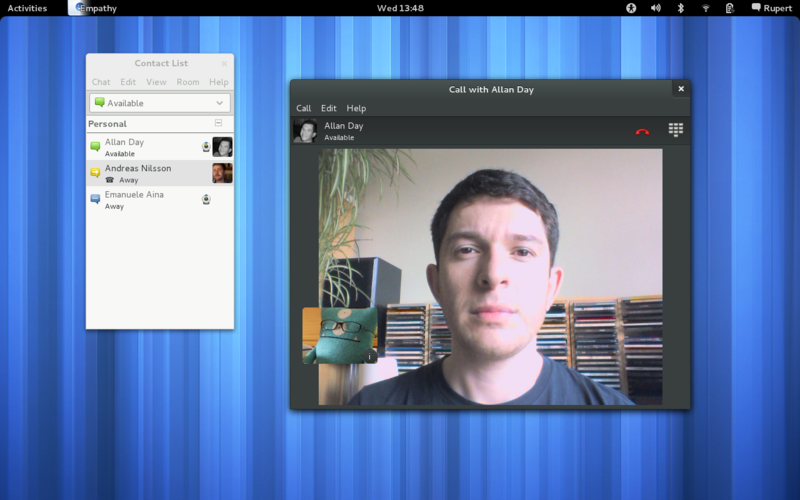
3.4
includes a number of improvements to the Empathy chat
application. Foremost among these is its brand new audio and video
calling interface. This provides a really nice way to do video
calling, and it is fully integrated into GNOME 3, so you can quickly
and easily respond to video calls as they come in.
Another
major enhancement to Empathy for this release is the new
support for both Windows Live Messaging and Facebook chat, so that
chatting with your friends is easier than ever before.
There
are several other improvements included in this release of Empathy,
including:
- The accounts dialog has been partially re-designed, giving it a simplified interface that is easier to use.
- Improved integration with Contacts, which simplifies the user interface and means that Empathy can take advantage of Contacts' features, such as linking suggestions.
Many Application Enhancements
There
are plenty of other improvements to our applications in this release.
As well as the usual bug fixing work, there are visible enhancements
and new features. Here are some of them:
- The file manager Nautilus now includes an Undo function which allows you to revert changes you might have made. Great for correcting mistakes!
- The Sound Juicer CD ripper has a new metadata fetching facility which provides enhanced support for multi-disc albums.
- The text editor gedit will now run on Mac OS X as well as GNOME.
- The webcam booth Cheese now uses WebM as its default video format (instead of Theora).
- Our games have been modernized. Status bars have been removed, application menus added, and more.
- Image Viewer (used to be called Eye of GNOME) has a new image metadata sidebar. This makes it easy to browse images and see their properties at the same time.
- It is now possible to use Evolution to connect to Kolab Groupware servers. It is possible to use multiple Kolab accounts at the same time. Full offline support, extended free/busy lists, and synchronization conflict detection and resolution are also all supported.
- Evolution's account setup assistant will also automatically detect common email providers, making it less work to set up your email account. As an added bonus, it will now also let you reorder your email accounts in the sidebar.
What's New in Accessibility
GNOME
3.4 is the most accessible version of GNOME 3 to date, with an
emphasis on being reliable and usable for everyone. GNOME has started
a Friends
of GNOME fundraising campaign
in order to strengthen its commitment to accessibility with more
resources and make 2012 the Year of Accessibility for GNOME.
This
release includes some significant enhancements to GNOME's
accessibility features. These include:
Improved Orca Integration
GNOME
3 support for screen readers has been improved. This means that users
of the Orca screen reader can now use GNOME 3 as their
computing environment. This integration will be further developed in
future releases, and we encourage Orca users to provide
feedback.
Orca's
performance has also been greatly improved this release. These
improvements mean that the new version is much faster and more
responsive.
Better High Contrast Mode
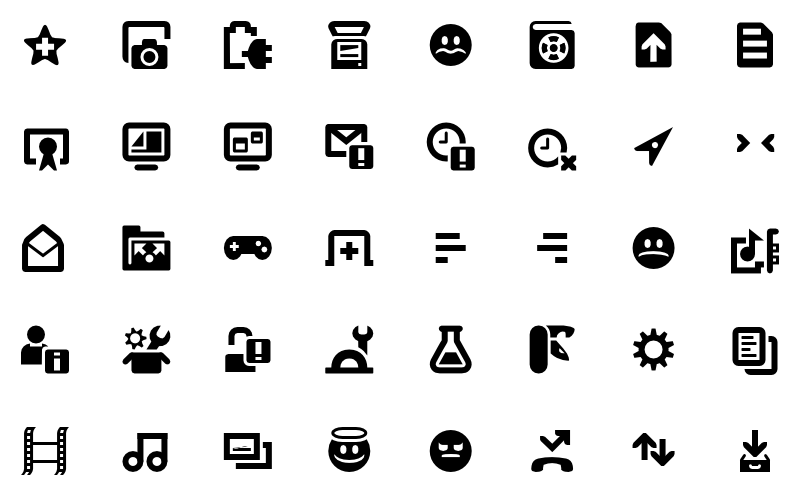
The
high contrast theme has received several improvements this cycle.
GNOME's new and refreshed interface components are now supported by
high-contrast mode. The high contrast icons that are used in this
mode have also been improved and extended, making high contrast look
better and cover more of GNOME.
Configure the Zoom to Suit You
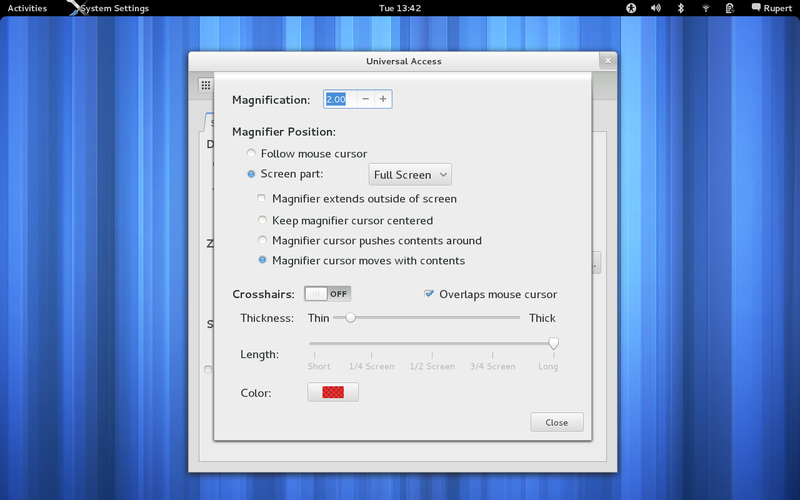
New
settings for configuring the zoom (or magnifier) feature have been
added for this release. The new zoom options allow you to change the
magnification factor, the mouse tracking, the position of the
magnified view on the screen and enable crosshairs to be added to
help you find the mouse or touchpad pointer.
What's New for Developers
The
following changes are important for developers using the GNOME 3.4
Developer Platform. If you are not interested in changes for
developers, you can skip forward to Section
5 ― Internationalization.
Included
in GNOME 3.4 is the latest release of the GNOME Developer Platform.
This consists of a set of API- and ABI-stable libraries available
under the GNU LGPL that can be used for the development of
cross-platform applications.
GLib 2.32
GNOME's
low-level software utility library GLib has seen various
improvements:
- GNOME's default storage backend GSettings received native support for Mac OS X. There is also betterGSettings support for plugins and extensions via GSettingsSchemaSource.
- GResource provides support for embedding resources in binaries
- Unicode 6.1 support
- New network status monitor interface: GNetworkMonitor
- GLib and GTK+ introduced versioned deprecations. By using GLIB_VERSION_MIN_REQUIRED (resp.GDK_VERSION_MIN_REQUIRED for GTK+) you can for example receive warnings about API that was deprecated before the last stable version but not for the latest 2.31 development version. Corresponding functionality exists for too new API by using GLIB_VERSION_MAX_ALLOWED (resp.GDK_VERSION_MAX_ALLOWED for GTK+).
GTK+ 3.4
GTK+
3.4 is the latest release of the GTK+ toolkit, which is at the heart
of GNOME. GTK+ 3.4 includes new features for developers, as well as
extensive bug fixes.
- More complete CSS support in theming and better transparency support in theming and backgrounds
- Improved cross-platform keyboard shortcut handling by using 'Primary' instead of 'Control'
- Basic support for touch events (and support for XInput 2.2): Widgets can get touch events by connecting to the GtkWidget::touch-event signal. GTK+ uses touch events to implement kinetic scrolling inGtkScrolledWindow and touch-compatible menu behavior
- Smooth scrolling support by the new scroll direction GDK_SCROLL_SMOOTH and the new event maskGDK_SMOOTH_SCROLL_MASK. gdk_event_get_scroll_deltas() provides the scroll deltas.
- Session support: GtkApplication supports log out notification and negotiation (similar to deprecated EggSMClient)
Clutter 1.10
GNOME's
graphics library for hardware-accelerated user interfaces Clutter
provides the following improvements:
- Multiple backend support: Clutter can be compiled with support for different platforms, and the backend can be selected at run time.
- Support for the password hint in text entries: When the password hint is enabled, the last character inserted into a text entry will be shown for a brief amount of time, as a way to safely enter passwords and other hidden content on platforms with imprecise text input (e.g. touchscreen keyboards).
- Use of the same definitions for versioned deprecations as GLib and GTK+ (see above).
- Better support on Mac OS X and Wayland.
- New scene graph API: ClutterActor is now the only class dealing with the definition of a scene inside a Clutter application. This deprecated most of the ClutterContainer interface and ClutterGroup,ClutterRectangle and ClutterBox.
- New implicit animation API for ClutterActor.
- New ClutterContent interface, with two implementations: Canvas for Cairo drawing; and Image for displaying image data; the Content interface supports the new render objects API for painting the actor's content.
- Performance improvements on the GLSL-based effects shipped by Clutter.
- New brightness-contrast effect.
DConf
GNOME's
default GSettings backend has seen several improvements:
- DConf can now read from multiple user configuration databases. The dconf profile format now explicitly identifies user and system dconf databases, rather than assuming that only the first line specifies a user database. Users interested in sharing part of their dconf profile between multiple systems, such as via a version-controlled home directory, can use this support to read from a shared dconf database in addition to the live-writable dconf database.
- DConf now supports dconf profiles specified by an absolute path in $DCONF_PROFILE, rather than just a path relative to /etc/dconf/profiles/. This allows users to specify a profile in their own home directory, such as to specify multiple user databases.
Use of Deprecated Libraries
Further
progress has been made in the continuous work of replacing outdated
technologies with superior facilities.
- Several applications (such as gdm, gnome-control-center, gnome-games, gthumb, gucharmap, metacity,mutter and Rhythmbox) now use GSettings as their storage backend instead of deprecated GConf. Formutter this meant some keybinding changes.
- libgoffice, libgnomekbd and libxklavier received GObject introspection support which makes the API of those modules automatically available to a wide variety of other programming languages and runtimes. On a related note, gevice was converted from using static deprecated Python bindings to using introspection.
- Several packages (such as gnome-bluetooth, gnome-control-center, gnome-settings-daemon, gnome-shell,sound-juicer) have been converted from using dbus-glib to GDBus and from libunique toG(tk)Application.
Miscellaneous Developer Updates
Other
GNOME Platform improvements in GNOME 3.4 include:
- The project management of the Integrated Development Environment Anjuta is now much easier to use and more powerful. The application received a new "Find in files" dialog that allows you to search project files, and filter on directories and/or file types. The search supports regular expressions and you can also replace in all or only a subset of the results. Anjuta also improved its integration with the User Interface DesignerGlade by allowing to automatically connect widgets and code.
- Several applications (such as gnome-dictionary, gnome-system-monitor, transmageddon) provide improved cross-desktop compatibility by inheriting the freedesktop.org directory specification.
- Developers that use the text editor gedit can use the new plugin gedit-code-assistance which provides code assistance for C, C++ and Objective-C by utilizing clang and code assistance for Python.
- Evolution-Data-Server previously downloaded all (old) messages when adding an IMAP account. Now you can define to only download older messages when required. This saves bandwidth and disk space. It also saw several synchronization API improvements with regard to performance and convenience.
- PyGObject's new pygtkcompat.py module provides easier backwards compatibility to deprecated PyGTK.
- For your convenience Empathy includes a "Send to pastebin" option in its debug window.
Internationalization
Thanks
to members of the worldwide GNOME
Translation Project,
GNOME 3.4 offers support for more than 50 languages with at least 80
percent of strings translated, including the user and administration
manuals for many languages.
Supported
languages:
- Arabic
- Assamese
- Asturian
- Basque
- Belarusian
- Brazilian Portuguese
- British English
- Bulgarian
- Catalan
- Catalan (Valencian)
- Chinese (China)
- Chinese (Hong Kong)
- Chinese (Taiwan)
- Czech
- Danish
- Dutch
- English (US)
- Estonian
- Finnish
- French
- Galician
- German
- Greek
- Gujarati
- Hebrew
- Hindi
- Hungarian
- Indonesian
- Italian
- Japanese
- Korean
- Latvian
- Lithuanian
- Macedonian
- Norwegian Bokmål
- Polish
- Portuguese
- Punjabi
- Romanian
- Russian
- Serbian
- Slovenian
- Spanish
- Swedish
- Tamil
- Telugu
- Thai
- Turkish
- Uighur
- Ukrainian
- Vietnamese
Many
other languages are partially supported, with more than half of their
strings translated.
Translating
a software package as large as GNOME into a new language can be an
overwhelming task for even the most dedicated translation team. For
this release a stellar effort has been done by the Belarusian team,
increasing the completeness of their translation by more than 39
points since version 3.0. Also to be congratulated are the Khmer team
with 24 points more than in version 3.2 and the Macedonian team as
they raised their translation status 21 points since 3.2.
Getting GNOME 3.4
To
install or upgrade your machine to GNOME 3.4, we recommend you
install the official packages provided by your vendor or
distribution. Popular distributions will make GNOME 3.4 available
very soon, and some already have development versions with GNOME 3.4
available.
If
you want to try out GNOME, download one of our live images. These are
available on our Getting
GNOMEpage.
If
you are brave and patient, and would like to build GNOME from source,
we recommend you use JHBuild,
which is designed to build the latest GNOME from Git. You can use
JHBuild to build GNOME 3.4.x by using thegnome-3.4
moduleset.
Reference:
https://help.gnome.org/misc/release-notes/3.4/#rnusers.hardware
Retrieved August 2013
No comments:
Post a Comment